Have you come across a 1927 wheat penny in your collection of old coins? Since it’s almost a hundred years old, you might be curious whether it’s a rare and valuable find.
This article offers details about the value of the 1927 wheat penny, including all three mint versions issued that year. You’ll also learn about its background, how coin grading works, and which minting errors to watch for, so you can better assess the value of your coin.
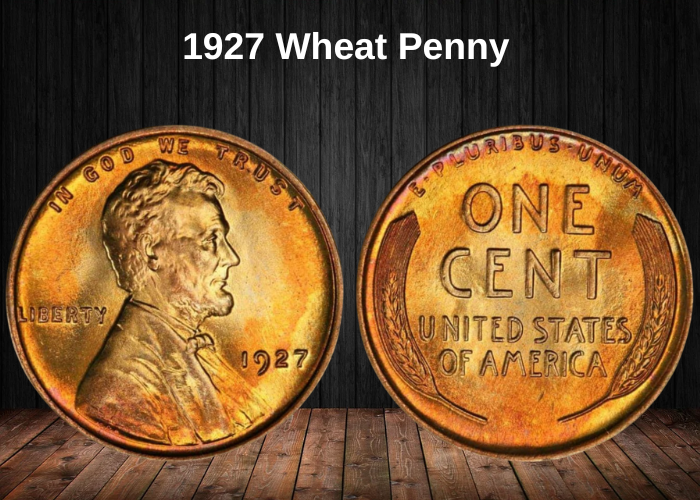
1927 Wheat Penny Value Table
| Mint Mark | Very Good (VG8) | Extremely Fine (EF40) | About Uncirculated (MS50) | Uncirculated (MS60) | Uncirculated (MS63) |
|---|---|---|---|---|---|
| 1927 (no mint mark) | $0.35 | $2 | $5 | $11 | $19 |
| 1927 D | $1 | $14 | $24 | $65 | $105 |
| 1927 S | $1.50 | $15.50 | $38 | $75 | $190 |
The wheat penny has a long history, dating back over a century. It was the first U.S. coin to feature a real person—President Abraham Lincoln—on its front side.
These coins get their nickname from the two wheat stalks shown on the reverse. They were introduced in 1909 to mark the 100th anniversary of Lincoln’s birth and continued to be minted until 1959. That year, the reverse was changed to feature the Lincoln Memorial in honor of his 150th birthday.
The wheat penny holds a special place in U.S. numismatic history because it was the first time a real individual was depicted on American coinage. Before this, only symbolic figures appeared on coins.
The idea of putting Lincoln on the penny came from then-president Theodore Roosevelt, who deeply admired Lincoln and wanted to honor him with a commemorative coin. The winning design was created by sculptor Victor David Brenner—though it did face some criticism at the time.
Tensions at the U.S. Mint
When the U.S. Mint decided to update the Indian Head penny, they rejected the ideas proposed by Chief Engraver Charles Barber and instead chose the design by Victor David Brenner, who had been recommended by President Theodore Roosevelt. Barber, unhappy with the decision, attempted to interfere with Brenner’s work. Some of his suggestions—such as lowering the portrait on the obverse—were actually adopted.
Further conflict arose when Mint officials told Brenner he could not put his full last name on the coin. Instead, he was only allowed to use his initials “V.D.B.”. Brenner agreed to the change, but after just 484,000 pennies were minted with the initials, production was halted, and the initials were removed.
While some claim the initials were seen by the public as too prominent or self-promotional, others believe the decision was influenced by Barber’s objections. Regardless of the reason, Brenner’s initials were not added back to the coin until 1918, a year after Barber’s death in 1917.
1927 Wheat Penny Grading
Like all U.S. coins, 1927 wheat pennies are evaluated using the Sheldon Scale, a standardized system for grading coin condition. The scale begins at PO1 and PO2, which are assigned to the lowest-quality, heavily worn coins. It then progresses through “Good” and “Fine” grades, which are numbered 3 to 59—these represent coins that have been in circulation and show varying degrees of wear.
Grades from 60 to 70 apply to uncirculated coins, meaning they have retained most of their original detail and have little to no visible wear. These grades are labeled with the letters MS, standing for Mint State. A coin graded MS70 is considered to be in perfect condition, which is extremely rare.
Grading Breakdown
| # | Grade Description |
|---|---|
| 1 | Basal State-1 |
| 2 | Fair |
| 3 | Very Fair |
| 4, 5, 6 | Good |
| 7, 8, 10 | Very Good |
| 12, 15 | Fine |
| 20, 30 | Very Fine |
| 40 | Extremely Fine |
| 50 | About Uncirculated |
| 60 | Mint State (MS60) |
| 65 | Mint State (MS65) |
| 70 | Mint State (MS70) |
Be sure to consult our grading guides to accurately determine your coin’s grade. This is an essential step in identifying the true value of your 1927 wheat penny.
Wheat Penny Color Grading
If you’ve seen the abbreviations BN, RB, and RD in coin grades—especially in auction listings—these refer to the color of copper coins, which is an important factor in determining a penny’s value.
- BN means Brown
- RB means Red-Brown
- RD means Red
A coin that still shows 95% or more of its original red surface qualifies for the RD (Red) designation. On the other hand, if 95% or more of the surface has turned brown, the coin is labeled BN (Brown). Coins that fall somewhere between these two extremes are classified as RB (Red-Brown).
This matters because copper starts out red when freshly minted, but it oxidizes over time, turning brown as it’s exposed to air and other elements. As a result, color is a strong indicator of the coin’s condition. Coins that still retain their red hue are typically more attractive to collectors and tend to fetch higher prices.
1927 No Mint Mark Wheat Penny Value
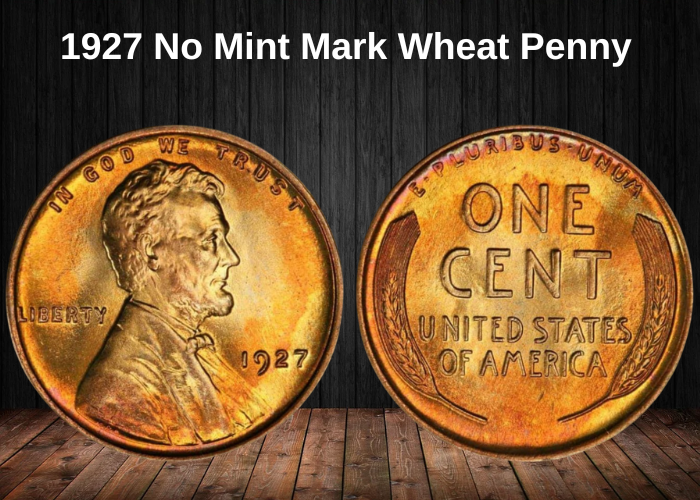
In 1927, the Philadelphia Mint produced the highest number of wheat pennies by a wide margin. That year, the facility struck a total of 144,440,000 coins, which is why 1927 pennies without a mint mark are still relatively easy to find, especially in lower grades. Due to their abundance, they are also the least valuable of the three mint varieties from that year.
For example, a 1927 no mint mark wheat penny graded VG8 is worth around $0.35, and even at EF40, it’s only about $2. If the coin is uncirculated, prices start around $11 at MS60—which is significantly less than the $65 for a Denver-minted coin or the $75 for one from San Francisco at the same grade.
Although most prices aren’t especially high, 1927 Philadelphia pennies can still fetch strong prices at auction if they are in exceptional condition. For instance:
- An MS66BN penny sold for $350
- An MS64RB sold for $175
- The highest auction price ever recorded was $8,638 for a MS67+RD penny
So, while most examples may not be rare, the finest quality coins can still be highly valuable to collectors.
The Obverse of the 1927 Wheat Penny
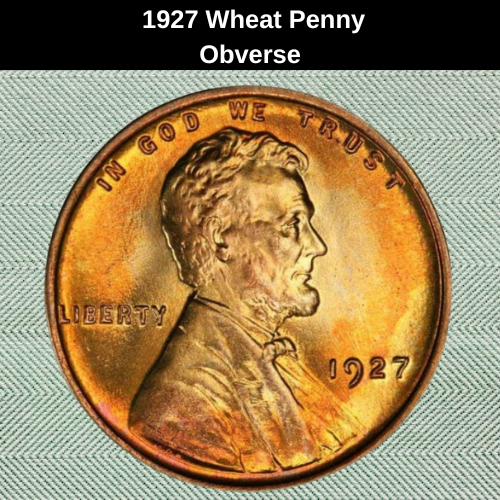
The front (obverse) side of the 1927 wheat penny features a right-facing portrait of Abraham Lincoln, created by designer Victor David Brenner. Just to the right of Lincoln’s portrait, near the bottom, is the minting year “1927”.
On coins struck at the Denver (D) and San Francisco (S) mints, you’ll find the mint mark directly below the date. For Philadelphia-minted coins, which don’t carry a mint mark, this space is left blank.
To the left of Lincoln’s profile appears the word “LIBERTY”, and the phrase “IN GOD WE TRUST” is inscribed along the top edge of the coin. After Brenner’s initials were reintroduced, they were placed on the cutoff of Lincoln’s shoulder, a subtle but identifying feature.
The Reverse of the 1927 Wheat Penny
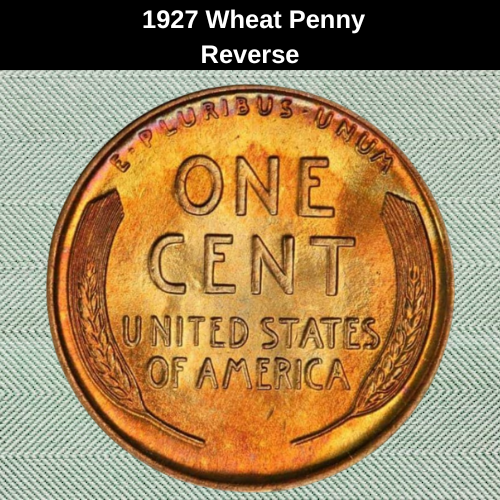
The reverse side of the 1927 wheat penny displays two curved durum wheat ears, one on each edge of the coin—this distinctive design is what gave the coin its “wheat penny” nickname.
At the center of the reverse, you’ll see the denomination “ONE CENT”, with “UNITED STATES OF AMERICA” placed just below it. Across the top of the coin, the Latin motto “E PLURIBUS UNUM”, meaning “Out of many, one,” is clearly inscribed.
Other Design Details of the 1927 Wheat Penny
In 1927, the three U.S. Mint facilities collectively produced a total of 185,886,000 wheat pennies. Each coin has a diameter of 19.05 millimeters, a weight of 3.11 grams, and a thickness of just 1 millimeter.
The coins are perfectly round with smooth (plain) edges. In terms of composition, they were made from 95% copper and 5% tin and zinc, a typical metal mixture for U.S. pennies of that era.
1927 D Wheat Penny Value
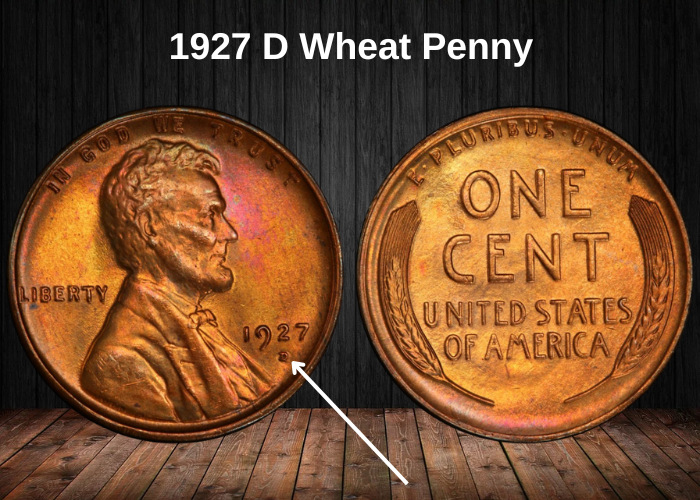
The Denver Mint struck a total of 27,170,000 wheat pennies in 1927, making them less common than their Philadelphia counterparts, especially in higher grades. However, they are generally less valuable than the San Francisco-minted coins from the same year.
If you own a 1927-D wheat penny in very good circulated condition, its value is around $1. In extremely fine circulated condition, the price increases to about $14. A coin graded as about uncirculated—meaning it is nearly as well-preserved as an uncirculated coin—can fetch around $24.
For uncirculated coins, prices begin at $65 for MS60 and go up to $105 for MS63.
Auction records show the potential for much higher values:
- An MS66BN 1927-D penny sold for $1,045
- An MS66+RB example reached $6,300
- An MS65RD specimen sold for $4,680
These figures highlight the value of high-grade, well-preserved Denver-minted wheat pennies from 1927.
1927-S Wheat Penny Value
The San Francisco Mint produced the fewest pennies in 1927, releasing only 14,276,000 coins into circulation. This scarcity is clearly reflected in both their market values and auction records.
A 1927-S wheat penny graded VG8 is worth around $1.50, but values increase significantly with condition:
- At EF40, the coin is worth approximately $15.50
- In AU50 (About Uncirculated) condition, the value climbs to about $38
- For uncirculated examples, prices begin at $75
In terms of auctions, these coins are considered much harder to find in high grades compared to the Philadelphia and Denver varieties:
- An MS65BN 1927-S penny sold for $3,120
- An MS65RB fetched an even higher $6,463
- The highest auction record was set in 2022, when a 1927-S wheat penny graded MS65+RD sold for a staggering $36,000
These figures make the San Francisco variety the most valuable and sought after of the 1927 wheat pennies, especially in top condition.
Rare 1927 Wheat Penny Error Lists
1927 Wheat Penny Repunched Mint Mark Error
A repunched mint mark (RPM) error occurs when the mint mark is struck more than once on a coin. This usually happens if the first impression was faint or misaligned, prompting a second strike to correct it.
One notable example from the 1927 wheat penny series is the D/D North error variety. In this case, the original “D” mint mark from the Denver Mint was too weak, so it was repunched slightly north of the initial mark. As a result, the stronger mint mark appears just above the original, creating a visible doubling effect.
This variety is highly collectible, and an example graded MS64RB has reached an auction record of $1,175—making it a valuable find for collectors who spot this rare error.
1927 Wheat Penny Doubled Die Obverse Error
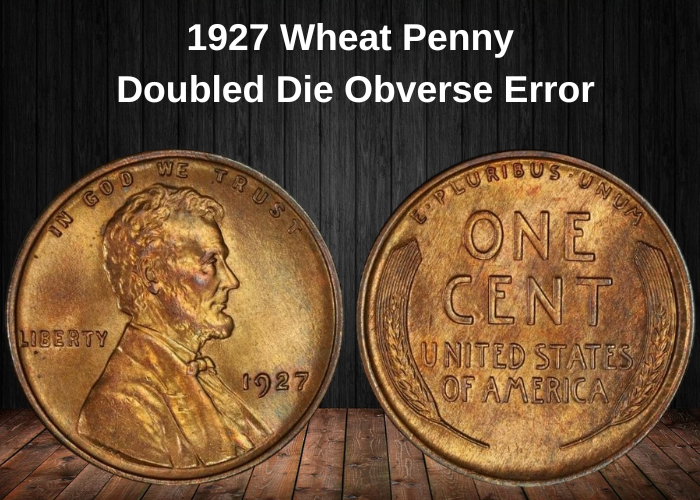
A doubled die obverse (DDO) error occurs when there’s a mistake during the die creation process, causing certain design elements to be duplicated on the die itself. This results in a doubled image on the coin, often with a slight offset that is visible to the naked eye.
It’s important not to confuse this with a double-strike error, which happens when the coin (planchet) is struck twice by the same die. In contrast, a doubled die error comes from a flawed die being used to strike the coin.
This type of error can be found on 1927 wheat pennies minted in Philadelphia. To identify one, look closely for doubling on the letters “LIB” in the word LIBERTY. Doubling may also appear on parts of the inscription “IN GOD WE TRUST”, as well as on the digits “2” and “7” in the date.
An example of this error, graded MS64RD, holds the auction record at $2,613, making it a highly desirable piece for collectors.
Where to sell your penny?
Now that you know the value of your penny, you might be wondering where to sell it. Don’t worry: here’s a guide to some of the best online platforms where you can easily sell your coins, along with their advantages and disadvantages.
Discover the best platforms for selling coins online (pros and cons).
1927 Wheat Penny Frequently Asked Questions
1. Why is the 1927 Wheat Penny considered significant despite its high mintage numbers?
While the 1927 Wheat Penny had a relatively high mintage—especially from the Philadelphia Mint—its significance lies in its role during the tail end of the Roaring Twenties. It serves as a historical artifact from a pre-Depression era, capturing a moment in American optimism before the economic collapse of 1929.
2. What makes the 1927-S Wheat Penny a more desirable coin for collectors compared to the 1927 and 1927-D issues?
The 1927-S had a relatively lower mintage (14,276,000), and coins from the San Francisco Mint often show weaker strikes due to worn dies. Finding a sharply struck, high-grade 1927-S penny is challenging, making it significantly more desirable in uncirculated condition.
3. How does strike quality vary between 1927 pennies from different mints, and how does this affect market value?
Philadelphia-minted coins typically exhibit sharper details, while Denver and especially San Francisco strikes are often softer. A well-struck 1927-S with crisp details can command a premium far above its nominal book value due to its relative rarity in such condition.
4. Are there any known die varieties or errors in the 1927 Wheat Penny series that can significantly increase a coin’s value?
Though major errors are rare for 1927, collectors occasionally find die cracks, die clashes, or off-center strikes. These anomalies—especially when paired with a clean, uncirculated coin—can increase its value among error collectors.
5. What role does luster play in differentiating values of 1927 Wheat Pennies graded MS63 and higher?
Luster is a critical factor in determining value at high Mint State grades. A 1927 penny with full, original red luster (graded as MS63 RD or higher) can be significantly more valuable than the same coin with brown toning (BN). The premium on red specimens stems from their rarity due to oxidation over time.
6. How did the economic and political context of 1927 in the U.S. influence the coin’s production and design stability?
The U.S. in 1927 was experiencing strong economic growth, and the Mint had little incentive to change the design or coinage process. This stability ensured consistency in Wheat Cent design, but also means fewer anomalies—making even minor variations from that year more collectible due to their scarcity.
7. From a long-term investment perspective, which variety of the 1927 Wheat Penny shows the most potential for appreciation, and why?
The 1927-S Wheat Penny in MS64 or higher, especially with strong strike and red color designation, holds the most appreciation potential. Its scarcity in such condition and growing demand for high-grade early Lincoln cents make it a strong candidate for long-term growth.



















































